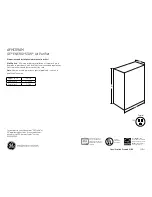
Page 11
To Open Liquid or Suction Line Service Valve:
1− Remove stem cap with an adjustable wrench.
2− Using service wrench and 5/16" hex head extension
back the stem out counterclockwise until the valve stem
just touches the retaining ring.
3− Replace stem cap and tighten finger tight, then tighten
an additional 1/6 turn.
Do not attempt to backseat this valve. Attempts to
backseat this valve will cause snap ring to explode
from valve body under pressure of refrigerant.
Personal injury and unit damage will result.
DANGER
To Close Liquid or Suction Line Service Valve:
1− Remove stem cap with an adjustable wrench.
2−Using service wrench and 5/16" hex head extension, turn
stem clockwise to seat the valve. Tighten firmly, but do not
overtighten.
3− Replace stem cap. Tighten finger tight, then tighten an
additional 1/6 turn.
SUCTION LINE (BALL TYPE) SERVICE VALVE
HS26−060 MODEL ONLY
(VALVE OPEN)
FIGURE 14
SCHRADE
R VALVE
SERVICE PORT
SERVICE
PORT
CAP
STEM CAP
INLET
(FROM INDOOR COIL)
OUTLET
(TO
COMPRESSOR)
STEM
USE ADJUSTABLE WRENCH
ROTATE STEM CLOCKWISE 90
_
TO CLOSE
ROTATE STEM COUNTERCLOCKWISE 90
_
TO OPEN
BALL
(SHOWN OPEN)
V−CHARGING
The unit is factory−charged with the amount of R22 refrig
erant indicated on the unit rating plate. This charge is
based on a matching indoor coil and outdoor coil with a 25
foot (7.6m) line set. For varying lengths of line set, refer to
table 8 for refrigerant charge adjustment for both, early and
late model HS26 units. A blank space is provided on the
unit rating plate to list actual field charge.
TABLE 8
LIQUID LINE
SET DIAMETER
Ounce per 5 ft. (ml per mm) adjust
from 25 ft. (7.6m) line set*
5/16 in. (8mm)
2 ounce per 5 ft. (60 ml per 1524 mm)
3/8 in. (10 mm)
3 ounce per 5 ft. (90 ml per 1524 mm)
If line set is greater than 25 ft. (7.6m) add this amount. If line set is less
than 25 ft. (7.6m) subtract this amount.
Units are designed for line sets up to 50 ft. (15m).Consult Len
nox Refrigerant Piping Manual for line sets over 50 ft. (15m).
IMPORTANT
If line length is greater than 25 feet (7.6m), add this
amount. If line length is less than 25feet ( 7.6m),
subtract this amount.
A−Leak Testing
1− Attach gauge manifold and connect a drum of dry nitro
gen to center port of gauge manifold.
2− Add a small amount of refrigerant to the lines and
coil. Open high pressure valve on gauge manifold
and pressurize line set and indoor coil to 150 psig
(1034 kPa).
WARNING
Danger of Explosion.
Can cause injury, death and equipment
damage.
When using dry nitrogen, use a pres
sure−reducing regulator, set at 150 psig
(1034 kPa) or less to prevent excessive
pressure.
3− Check lines and connections for leaks.
NOTEIf electronic leak detector is used, add a trace of re
frigerant to nitrogen for detection by leak detector.
4− Release nitrogen pressure from the system, correct
any leaks and recheck.
B−Evacuating the System
Evacuating the system of non−condensables is critical for
proper operation of the unit. Non−condensables are defined
as any gas that will not condense under temperatures and
pressures present during operation of an air conditioning
system. Non−condensables such as water vapor, combine
with refrigerant to produce substances that corrode copper
piping and compressor parts.




































